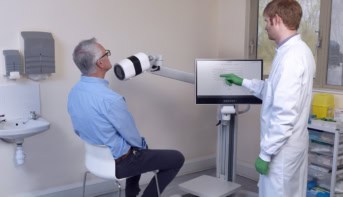Available to watch now, LAP GmbH Laser Applikationen explores how the Raigmore Hospital in Inverness recently used RadCalc EPID for patient-centric quality assurance
Want to learn more on this subject?
 Radiotherapy treatment involves the delivery of high doses of radiation, targeted at a tumour, but often in close proximity to other critical organs. Radiotherapy treatments are planned on computers using a combination of a machine beam model and a scanned patient geometry. This treatment plan may then be delivered to the patient daily over a period of several weeks. The success of the treatment depends on the precision of the dose delivery and this can be affected by a number of factors including the accuracy of the beam model, machine issues, patient setup and physical changes to the patient.
Radiotherapy treatment involves the delivery of high doses of radiation, targeted at a tumour, but often in close proximity to other critical organs. Radiotherapy treatments are planned on computers using a combination of a machine beam model and a scanned patient geometry. This treatment plan may then be delivered to the patient daily over a period of several weeks. The success of the treatment depends on the precision of the dose delivery and this can be affected by a number of factors including the accuracy of the beam model, machine issues, patient setup and physical changes to the patient.
RadCalc EPID offers a method of calculating the dose that was delivered to the patient using images of the beam that are collected as it exits the patient. The most simplistic use of this data is to ensure that no gross error has occurred during treatment delivery. However, the sensitivity of the system is such that it can detect much smaller deviations, helping to identify both systematic issues and patient-specific problems.
This webinar covers the use of RadCalc EPID at Raigmore Hospital in Inverness. Use of the system will be discussed along with examples of the types of problems that have been discovered, along with their resolution.
Want to learn more on this subject?

Steve Colligan is head of radiotherapy physics at Raigmore Hospital in Inverness, Scotland. Having gained an honours degree in electrical and electronic engineering at the University of Edinburgh, he pursued an MSc in medical physics at the University of Aberdeen. After graduating, he worked in clinical scientist roles at both Walsgrave Hospital in Coventry and Raigmore Hospital in Inverness before being appointed to his current head of department role. In addition to maintaining a clinical role, he is actively involved in a number of the department’s projects that aim to make improvements to the accuracy of treatment delivery using tools such as transit dosimetry and surface image guidance. His other interests include radiobiology and programming.



